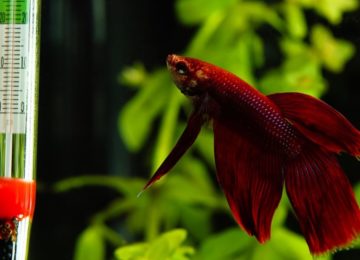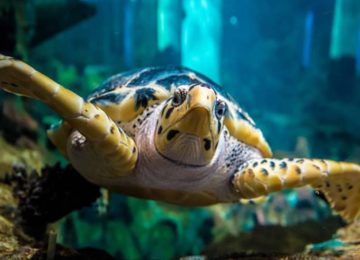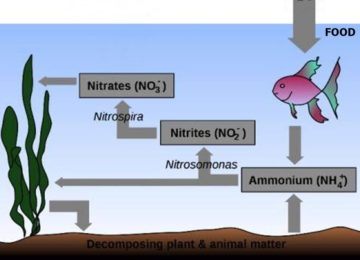Aquaponics is an innovative and sustainable solution of combining the fish and plants culture in a symbiotic recirculating system. This bio-integrated system uses waste from aquaculture to grow plants hydroponically.
Aquaponics is done with a wide variety of system designs, plant, and aquatic animal species. Different type of fish species and plants are used depending on different factors. Check the most common fish used in aquaponics here.
The aquaponic system increases the productivity of water by producing fish and plants without any need for water exchange or fertilizer. To ensure a sustainable aquaponics system you need to have proper fish to plant ratio.
Table of Contents
Why do you need an Optimum fish to plant ratio?
Every aquaponist may want to maximize your return on investment (ROI) on Fish and plant in the shortest time possible with lowest possible risks. For a most efficient aquaponics system, you must maintain the optimum balance between nutrient production from fish culture and nutrient uptake by the plant component.
Water quality for Fish Growth
The highly toxic ammonia and nitrites produced from the waste of fish need to be removed. The high level of nitrite can cause nitrite poisoning in the tank and kill the fish. Plants act as biofilter that needs to be large enough to process all of the fish wastes and filter the water.
Fewer plants may grow well but may not be able to remove contaminants from water efficiently. You may end up reducing the fish feed to control waste leading to slower growth of fish. Otherwise, the bad water quality (nitrate/nitrite levels, DO, etc) also results in poor Feed Conversion Ratio (FCR).
Nutrient for Plant Growth
In aquaponics, plants thrive on nutrients produced from the waste of fish. There should be enough number of fish and must be feed enough to supply adequate nutrients for the plants. induced poor production of lettuce plants (increased removal of minerals by plants).
Higher plant density results in suitable water quality and good fish production without the exchange of large quantities of water or complex biofiltration devices.
Factors influencing the Ratio
Every aquaponics system made is necessarily different in terms of a lot of factors i.e. fish species, plants choice, system size, design. You need to be aware of the effect of the following different factors on the growth of fish and plants. This will eventually lead to the optimum fish to plant ratio for your aquaponics system.
1. Feeding Rate
Let’s discuss the most important and directly impacting factor first. The fish to plants ratio is directly dependant on the feeding rate in a properly maintained aquaponic system. In general, fishes use about 80% of food and excrete the rest 20% as waste.
The amount of feed fed to the fish daily is considered for per square meter of plant growing area. Generally, 100 grams of fish food will support about one square meter of plant life. There is more information about determining this ratio in the lower section of this post. The optimum feeding rate ratio further depends on several factors such as grow bed type, plants type, and fish species. The NFT system roughly require 25% of the ratio of feeding rate used for a raft system.
2. Plants Choice
The nutrients concentration needed by plants largely depends on their type. Different plants have different nutrient requirements.
The plants that require low to medium nutritions include lettuce, herbs, onion, cabbage, cauliflower, garlic, peas and especially green vegetables (spinach, chives, basil etc.).
The flowering and fruiting plants like tomatoes and cucumbers have higher nutritional requirements. They need heavily stocked and established aquaponic system to grow better. If you’re growing indoors, they also need full spectrum LED grow lights for their vegetative and flowering phases.
3. Fish Species
The fish you’re going to keep is an important step in setting up the aquaponics system as this has a long-term impact. Any fish is suitable to produce waste to provide the ammonia and nutrients for plants.
However, some fish like trout needs high-quality water and you will need to grow more plants to minimize the waste in the water. Some species like tilapia can tolerate low quality water and can be stocked in higher densities. Check the important things to consider when choosing fish for aquaponics.
Any native fish that can accept feed is a good choice. Check over 10 popular fish used in aquaponics systems.
4. Stocking Densities
Stocking densities mean the fish amount you have kept in your system. You can not keep more than a specific amount of fish in the aquaponics system. Otherwise, fish can even die due to low dissolved oxygen, high nitrite level or simply kill each other because of territorial behavior. Some fish like tilapia breed rapidly and can overstock a system. Read more about using tilapia in aquaponics here.
The total fish length is considered for stocking density rather than the number of fish. Read in detail about fish to water ratio here.
You have to manage the fish stocking based on their size and feeding requirements. A handful of goldfish in your aquaponic farm need less feeding but that will result in lesser plant growth. You will also need to synchronize and consider the plants’ requirements after harvesting the fish (and vice versa).
5. System Age & Type
The system maturity is very important for a sustainable aquaponics system. To start an aquaponic system, you need to cycle your fish tank first.
The balance to maintain fish to plant ratio is tricky to achieve in a new system. It is generally best practice to start with a smaller amount of fish. Then increase the population as your plants grow or ensure the fish are growing at the same pace to provide enough nutrients for plants. This way, you also get a better sense of your environment.
Larger fish consume more food and produce more fertilizing waste. The size and type of aquaponic setup (Growbed, DWC or vertical) are also important as it tells the system’s ability to turn fish waste (ammonia) into nitrites, then nitrates (plant food). The more surface area your grow beds has, the more fish you can carry as they harbor your bacteria colony that do all the work.
In an established system, You will eat fish that reach plate size and plants all season as it grows. You need to maintain the ratio between plants and fish to ensure a working system balance.
6. Your Choice
Your choice impacts a lot in the end. Some like more fish and some like more plants. Those who want more fish than vegetables would use filters or some form of RAS approach. Some use goldfish and don’t eat the fish at all.
There is not a single optimum ratio for every combination/type of system, fish, and plants. So you will be playing with the above-mentioned factors to achieve the ratio you want! let’s move on to the final words about optimum fish to plants ratio.
What is the Optimum Ratio?
In general, it is recommended that fish tank volume should be approximately equal to the volume of the grow bed which makes the suitable grow bed to fish tank ratio equals to approximately 1:1. This ratio can also be termed and determined using different parameters. In terms of growing media, A normal balanced system would have around 25L of wet media per fish.
The most directly related factor in this ratio is the feeding rate. The most suitable ratio varies from 70 to 100 g/m2/day. i.e. if you feed fish 1000 g per day, the area of 10-14 m² should be devoted to hydroponics production. On another hand, if you have devoted 100 m² of an area for plants, you need to input feed of 7-10 KG ( 22 lbs). You can manipulate the fish, tank volume, and stocking densities to achieve your target ratio.
This ratio can also be determined in gallons per cubic foot (6 gallons (22 liters) of the fish tank to every cubic foot of grow bed).
In a commercial setup, this ratio can be increased to 1:3 or 1:4 depending on the fish density and water flow rate. The abundant aeration and fast water cycling also enable the commercial systems to stock fish as high as 1 fish per 8-10 liters of water. Research on an aquaponic system rearing Common carp and Mint suggests that the ratio 1:2 (fish: plant) showed optimum fish production, plant growth as well as nutrient removal.
You have to determine the ratio for your aquaponics system based on several choices you have made as listed above in the post. Fish growth can be higher in higher (1:3 ratios), whereas, plant production is better in a lesser 1:1 ratio. The rule of thumb is that you have to balance the nutrient generation from fish with nutrient removal by plants.




If I want to grow 300 indeterminate tomatos,and I want to use bass as my fish
What do I have to do and what is the rate of water flow
The water in fish tank must be cycled every hour, ideally up to 3 times an hour ( ie 1 IBC 1000-3000L per hr , it all comes down to your setup, normally have a solids separator, ie radial flow filter that then passes solids into a mineralization tank that can be processed slowly for nutrient dense liquid and the pre filtered remaining water gets quickly filtered through an MBBR, then split water flow at whatever flow rate you need for the garden beds to run , 300 tomato plants would require lots of fish. The TAN (total ammonia-nitrogen) production aquaponics needs 45kg of fish to supply enough nitrogen for 4,050 lettuce plants or 540 tomato plants.
I would like to share with you my experience in installing and running aquaponic system covered by hothouse. It was a surprise for me to manage to provide arrange of 11 to 13 g of fish feed per meter square per day while maintaining a good crop yields of lettuce, cucumber and coriander. This is far less what you mentioned (100g/m2/day) and also mentioned in other studies. Can you help me to understand this?
I want to grow pepper plants in a growing bed with a total of 24square meter, whta should be my feeding rate, stock density and fish tank volume if i want a 1:2 ratio fish:plant
Hi
Can you also give the fish to plants ratio for DWC floating raft system?